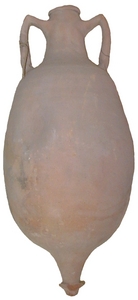Roman Amphorae: a digital resource
University of Southampton, 2005. (updated 2014) https://doi.org/10.5284/1028192. How to cite using this DOI
Data copyright © University of Southampton unless otherwise stated
This work is licensed under the ADS Terms of Use and Access.
Primary contact
Dr
David
Williams
Dept of Archaeology
University of Southampton
Avenue Campus
Highfield
Southampton
SO17 1BJ
England
Tel: 080 593032
Resource identifiers
- ADS Collection: 463
- DOI:https://doi.org/10.5284/1028192
- How to cite using this DOI
Pompeii 38

Courtesy of Dr. Imad Khalil / Graeco-Roman Museum at Alexandria
Imad Khalil
Distinctive FeaturesThis type is distinguished by its characteristic carinated shoulder, distinctive ringed spike and slightly peaked oval handles. The neck and body are both cylindrical.See characteristics | ||
Date RangeSciallano & Sibella (1991) suggest second to first centuries BC, although Martin-Kilcher (1994: 440) reports finds in a context dating to the late first century BC to the early second century AD.Search: [2nd century BC] [1st century BC] [1st century AD] [2nd century AD] | ||
OriginCnidos and the Datcha peninsula (Panella, 1986; Bezeczky, 2005).Search: [Greek Islands] [Western Asia Minor] | ||
DistributionItaly and the northern provinces (Panella, 1986; Martin-Kilcher, 1994; Bezeczky, 2005).Search: [Italy] [North West Europe] [Western Asia Minor] | ||
ContentsWine.Search: [Wine] | ||
CommentsPrincipal contributor: David Williams |



 3D models
3D models


